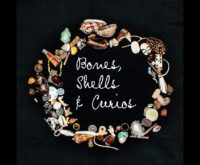
Bone Reading Journal
Journaling is something I learned as a tarot reader and which translated well to the bones. When you are first starting out, creating a journal will help you remember the meanings of your pieces, and over time it will serve as a record of your progress. If you are a long-time reader or a professional, a journal will help you to remember your client’s issues or your own, and what the bones said in previous readings on the same topic. With a photo of the reading or without, you can use your journal to jot down a few key points about the reading that you can use to refresh your memory should you revisit the issue, or if for a client you can refer to it if you recognize their name in the future. You can take photographs of your readings, print them out and glue them into your journal, or you can even keep your journal totally online with journaling software. The software usually lets you add photos to your entries easily.
Whenever I take a bone-reading class, I start a new journal just for that class. Classes often have specific sets of bones associated with them which are either included in the cost of the class or available as a separate purchase. In some classes the teacher gives you a list of materials you will need to make your set. I always get any bone set associated with a class if it is offered, or I put a set together according to the teacher’s specifications for the class. I then journal for that set just as if I were a beginner, drawing the pieces and writing down their meanings. Any notes I take from the class are put in the journal as well. I like to use a small (5”x7” or smaller) art book for this purpose because I will not be going any further with the class bone set once class is over, so I don’t need a lot of writing room. I am an inveterate collector of things I am interested in, so the bone set from the class will go into my collection.
Your journal need not be expensive – a notebook from the dollar store will suffice. One piece from your set per page will give you plenty of room for a hand drawn image or photo, your short, one- or two-word meaning, and plenty of space for you to expand upon that meaning as your understanding of the piece grows. Leaving the back of the page open will allow room for myths, stories, or experiences where that piece played a pivotal role. If you like to journal and you are a collector of stories, a loose-leaf journal might be best for you, as it allows you space to expand as your collection of stories and information grows.
Eventually, you may stop journaling about your set once you have been reading for a while and have formed a strong relationship with your set and its pieces. But starting out your journal can be a valuable tool. It is also a confirmation of your progress as a reader.
The lamp in the image was made by Professor Charles Porterfield.

These are wonderful tips on journaling. The Daily Throw exercises you have outlined have been a tremendous help in getting to know the bones better. I’m finding they are also helping me to build confidence in reading.
Thank you!